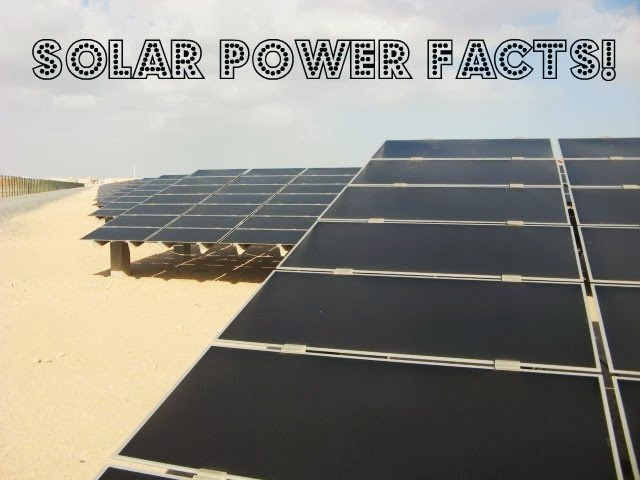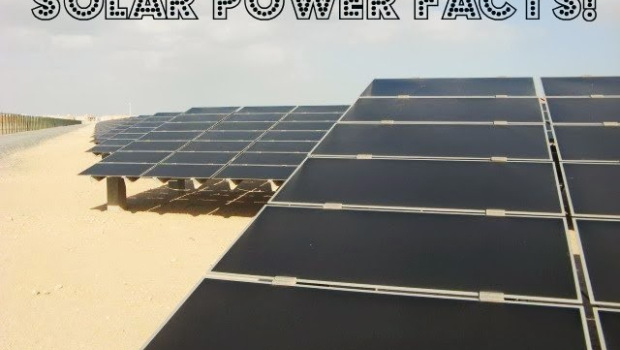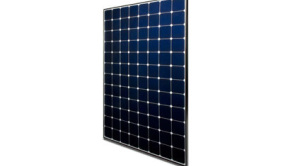Solar Energy & Solar Power Facts
Need some solar energy facts or solar power facts? This page is aimed at becoming the best go-to source on the web for solar facts… if it isn’t already. The solar facts below are succinct and organized by categories and subcategories. To help improve the page, please feel free to add any solar facts you are aware of in the comments below… or correct ours if we’ve got any wrong. If you do either of those things, just be sure to include a link to a reliable source — we want to be very careful here to check the facts before publishing them. Cool? Cool.

Solar farm in Masdar City, Abu Dhabi, UAE. Photo Credit: Marika Krakowiak / Solar Love
Solar Energy Facts / Solar Power Facts Table Of Contents
The main categories below are:
– Solar Records
- Solar Cell Efficiency Records
- Solar Module Efficiency Records
- Largest Solar Power Plants
- Solar Market Leaders
- Solar Vehicles
– Solar Policies
- Feed-in Tariffs
- Net Metering
- Value of Solar Tariffs
- Renewable Energy Standards (RES) / Renewable Portfolio Standards (RPS) / Renewable Obligation
- PACE Financing
- Solar Mandates
- Rebates, Tax Credits, Grants, & Loans
- Interconnection
- Permitting
- More Info, More Policies?
– How Solar PV Works
– Chime In!
Now, on to the solar energy and solar power facts!!
Solar Records
Solar Cell Efficiency Records
- Overall world solar cell efficiency record (also the concentrator triple-junction solar cell efficiency record) — 44.7% (Fraunhofer ISE)
- Triple-junction, non-concentrator solar cell efficiency record — 37.9% (Sharp)
- Two-junction, concentrator solar cell efficiency record — 32.6% (IES–UPM)
- Two-junction solar cell conversion efficiency record under one sun of illumination — 31.1% (NREL)
- Single-junction, concentrator solar cell efficiency record — 29.1% (FhG–ISE)
- Single-junction, GaAs, thin-film crystal solar cell efficiency record — 28.8% (Alta Devices)
- Crystalline silicon solar cell efficiency record — 24.7% (Panasonic)
- Amorphous and monocrystalline silicon solar cell efficiency record — 21.4% (EPFL Institute of Microengineering)
- Thin-film solar cell efficiency record — 20.8% (Centre for Solar Energy and Hydrogen Research Baden-Württemberg — ZSW)
- Black silicon solar cell efficiency record — 18.7% (Fraunhofer ISE & Aalto University)
- CZTS solar cell efficiency record — 12.6% (Solar Frontier, IBM, & TOK)
- Single-junction microcrystalline silicon solar cell efficiency record — 10.7% (EPFL Institute of Microengineering)
- Plasmonic polymer solar cell efficiency record — 8.92% (Ulsan National Institute of Science and Technology)
- Graphene solar cell efficiency record — 8.6% (University of Florida)
Solar Module Efficiency Records
- Overall solar PV module efficiency record (also the CPV module efficiency record) — 36% (Amonix)
- Outdoor solar PV (and CPV) module efficiency record — 34.9% (Amonix)
- Commercial CPV module efficiency record — 31.8% (Soitec)
- Commercial solar module efficiency record — 21.5% (SunPower)
- Leading solar modules in solar module yield field tests — SunPower SPR-327NE-WHT-D modules
- Thin-film solar module aperture efficiency record — 17.4% (Q-Cells)
- Cadmium-telluride (CdTe) photovoltaic (PV) module conversion efficiency record — 16.1% (First Solar)
- Flexible PV solar module efficiency record — 15.5% (MiaSolé)
- Monolithically integrated, commercially available CIGS module efficiency record — 13.4% (Stion) (also holds the 14.8% aperture efficiency record for such modules) and 13.4% (SoloPower)
Largest Solar Power Plants
PV
- Largest “collection” of solar power plants: 600 MW — Gujarat Solar Park
- Largest solar power plant under construction: 579 MW — Antelope Valley Solar Project
- Largest solar PV power plant completed: 290 MW — Agua Caliente Solar Project
CSP
- Largest concentrated solar thermal power (CSP) plant under construction: 370 MW — Ivanpah Solar Electric Generating System
- Largest CSP plant completed: 250 MW — Solnova Solar Power Station
- Largest single-unit CSP plant completed: 100 MW — Shams 1
CPV
- Largest concentrating photovoltaic (CPV) solar power plant: 37 MW — Alamosa Solar Generating Project
Solar Market Leaders
Global
- Solar Power (MW) Per Million People (End of 2012): 398.63 — Germany
- New Solar Power (MW) Per Million People In 2012: 108.98 — Bulgaria
- Solar Power (MW) Per $1 Billion GDP (End of 2012): 17.8 — Bulgaria
- New Solar Power (MW) Per $1 Billion GDP In 2012: 15.03 — Bulgaria
- Solar Peak Power Output Record: 22.68 GW — Germany
- Single-Year Solar Power Installation Record: 7.6 GW — Germany
US
- Solar Power (W) Per Capita (End of 2012): 166.9 — Arizona
- New Solar Power (W) Per Capita In 2012: 108.39 — Arizona
Module Manufacturers & Developers
- #1 solar module manufacturer (2012) — Yingli Green Energy
- #1 utility-scale solar developer in world — First Solar
- #1 EPC solar contractor in the world — First Solar
Solar Vehicles
- 1st solar-powered airplane to cross the US: Solar Impulse
- 1st solar-powered airplane to fly for 24 hours nonstop: Solar Impulse
- 1st solar-powered airplane to fly for 48 hours nonstop: Solar Impulse
- Solar-powered aviation world distance record on a single flight: 832 NM/ 1’541 km — Solar Impulse
Solar Policies
Feed-in Tariffs
The large majority of solar power around the world has been installed under feed-in tariff (FiT) programs. Very simply, a feed-in tariff program ensures that people who install solar power systems can then sell the electricity generated from those system back to the grid for a set price over a designated period of time. The goal of such policies is quite simply to increase solar power investments and growth, and therefore help drive down the cost of solar power systems. The specifics of the program can vary in numerous ways, such as:
- the size of eligible systems;
- the period of time in which the payments are guaranteed (e.g. 20 year, 15 years, etc);
- the rate for electricity generated from the solar power system.
Even though it was not yet called that, US President Jimmy Carter implemented the first feed-in tariff for solar. “While not called a feed-in tariff, the first form of feed-in tariff was implemented in the US in 1978 under President Jimmy Carter, who signed the National Energy Act (NEA).” Germany, however, pioneered the concept when it enacted its “Stromeinspeisungsgesetz” (StrEG) — or, “Law on Feeding Electricity into the Grid” — and even more so when it restructured that law as the Act on Granting Priority to Renewable Energy Sources (“Erneuerbare Energien Gesetz”, German Renewable Energy Act). As Wikipedia notes:
Germany’s new feed-in tariff made a number of important changes to its previous policy:
- first, the purchase prices were methodologically based on the cost of generation from renewable energy sources. This led to different prices for wind power, solar power, biomass and biogas sources, and geothermal energy, as well as different prices for projects of different sizes, to account for economies of scale;
- purchase guarantees were extended for a period of 20 years;
- utilities were now allowed to participate; and finally
- the rates offered were designed to decline annually based on expected cost reductions, in a mechanism known as “tariff degression”.
Since it has been the most successful, the German policy (amended in 2004 and 2008) often provides the benchmark against which other feed-in tariff policies are considered.
Indeed, FiTs have now been implemented in numerous countries around the world and have seen varying degrees of success, but the benchmark and by many standards most successful FiT today is Germany’s.
Net Metering
Net metering is a similar system for paying people for the electricity their solar panel systems generate and send back to the grid. Unlike FiTs, net metering isn’t as strongly geared at stimulating faster solar growth — it’s more geared at “fairly” paying someone for electricity they don’t use and send to the grid. (However, note the “Value of Solar Tariffs” discussed below, which are more geared at paying people for the true value of the electricity their solar panel systems generate). As the US Solar Energy Industries Association (SEIA) summarizes:
Net metering allows residential and commercial customers who generate their own electricity from solar power to feed electricity they do not use back into the grid. Many states have passed net metering laws. In other states, utilities may offer net metering programs voluntarily or as a result of regulatory decisions. Differences between states’ legislation and implementation mean that the benefits of net metering can vary widely for solar customers in different areas of the country….
Net metering is a billing mechanism that credits solar energy system owners for the electricity they add to the grid. For example, if a residential customer has a PV system on the home’s rooftop, it may generate more electricity than the home uses during daylight hours. If the home is net-metered, the electricity meter will run backwards to provide a credit against what electricity is consumed at night or other periods where the home’s electricity use exceeds the system’s output. Customers are only billed for their “net” energy use. On average, only 20-40% of a solar energy system’s output ever goes into the grid. Exported solar electricity serves nearby customers’ loads.
Value of Solar Tariffs
Net metering and feed-in tariffs are basically precursors to Value of Solar Tariffs (VOSTs). A VOST is actually geared at taking solar power’s various benefits into account (zero CO2 emissions, zero air and water pollution, peak power production, lack of need for new transmission, job creation, a price hedge against other electricity-generation technologies, etc.) and coming up with a set rate that a utility should pay for electricity generated from solar power.
The key with such a policy is deciding which benefits to include and how to calculate the benefits — this can sometimes or often be quite debatable. Early applications of such a concept have varied considerably.
Renewable Energy Standards (RES) / Renewable Portfolio Standards (RPS) / Renewable Obligation
In the US, a common renewable energy policy is the Renewable Energy Standard (aka Renewable Portfolio Standard). In the UK, the same concept is known as a Renewable Obligation. I prefer the term Renewable Energy Standard (RES), so I will use that for the rest of this section.
An RES is geared at increasing the production of renewable energy in a state, a utility’s jurisdiction, or another type of jurisdiction. Commonly, a percentage of the jurisdiction’s electricity supply is set as needing to come from renewable energy sources. Sometimes, specific renewable energy technologies (solar or wind, for example) are targeted and specific goals are set for their percentage of supply. Wikipedia’s entry on this policy option adds:
Most states with RPS programs have associated renewable energy certificate trading programs. RECs provide a mechanism by which to track the amount of renewable power being sold and to financially reward eligible power producers. For each unit of power that an eligible producer generates, a certificate or credit is issued. These can then be sold either in conjunction with the underlying power or separately to energy supply companies. A market exists for RECs because energy supply companies are required to redeem certificates equal to their obligation under the RPS program. State specific programs or various applications (e.g., WREGIS, M-RETS, NEPOOL GIS) are used to track REC issuance and ownership. These credits can in some programs be ‘banked’ (for use in future years) or borrowed (to meet current year commitments). There is a great deal of variety among the states in the handling and functioning of RECs and this will be a major issue in integrating state and federal programs.
In cases of RECs, “multipliers” may also be used to give more worth to electricity from certain sources. For example, if a multiplier of 3 were given to solar, one MWh from solar would be worth 3 MWhs from a “standard” REC.
PACE Financing
Property Assessed Clean Energy (PACE) financing is one of my favorites ways of supporting solar energy investments. Wikipedia (naturally) has a good summary of what PACE financing is:
In areas with PACE legislation in place municipal governments offer a specific bond to investors and then turn around and loan the money to consumers and businesses to put towards an energy retrofit. The loans are repaid over the assigned term (typically 15 or 20 years) via an annual assessment on their property tax bill. PACE bonds can be issued by municipal financing districts or finance companies and the proceeds can be used to retrofit both commercial and residential properties. One of the most notable characteristics of PACE programs is that the loan is attached to the property rather than an individual.
A key benefit of PACE financing is that a person can start saving money immediately through cuts in their electricity bills, assuming the electricity benefits beat the extra property tax payments… which they should.
DSIRE includes more information on specific property tax incentives across the US.
Solar Mandates
One would think solar mandates would have come onto the scene sooner, but they are actually a brand new policy in the United States (I’m not sure of their implementation outside the US).
The city of Lancaster (California) in early 2013 announced that it would implement a mandate requiring that new homes be constructed with solar panels. The policy goes into action on January 1, 2013.
Another Californian city, Sebastopol, soon followed with a similar mandate. However, in Sebastopol, the mandate is for commercial buildings as well as homes.
Rebates, Tax Credits, Grants, & Loans
Other common solar policies are rebates, tax credits, grants, and loans for solar power systems. Basically, these are exactly what you’d expect, simple financial ways in which federal governments, state governments, local governments, and utilities stimulate solar power investments and growth.
On the federal level in the US, the big incentives in this arena are the renewable energy Production Tax Credit (PTC) and the renewable energy Investment Tax credit (ITC).
DSIRE includes more information on the following:
- direct cash incentives
- tax credits
- sales tax incentives
- loan programs
- industry recruitment & support incentives
Interconnection
An often overlooked but important solar policy is a jurisdiction’s solar power interconnection policies. As DSIRE summarizes:
Interconnection standards specify the technical, legal and procedural requirements that customers and utilities must abide by when a customer seeks to connect a renewable-energy system to the grid. In states without comprehensive interconnection standards in place, it is often more difficult, more burdensome and more expensive for customers to connect a system to the grid. In general, states may regulate the interconnection of electricity-generating systems to distribution systems, while the Federal Energy Regulatory Commission (FERC) regulates the interconnection of systems to transmission lines.
Some states have adopted comprehensive interconnection standards that apply to all types and sizes of customer-sited systems, regardless of whether the system is net-metered. Some states have adopted interconnection standards that apply only to smaller systems that are net-metered. Some states have adopted interconnection guidelines that are vague and do not constitute standards. Other states have not adopted interconnection standards or guidelines. Comprehensive interconnection standards are developed by state public utility commissions, often when commissions directed to do so by state legislatures.
The technical issues related to interconnection are addressed by the IEEE 1547 Standard for Interconnecting Distributed Resources with Electric Power Systems. All states with comprehensive interconnection standards require compliance with the IEEE 1547 technical standard. However, the policy issues related to interconnection are more complex and vary by state. While some states’ interconnection standards apply to customers of all types of utilities (e.g., investor-owned utilities, municipal utilities and electric cooperatives), others apply only to customers of investor-owned utilities. In addition, state interconnection standards vary widely by several other key criteria, including individual system capacity limit, interconnection fees, use of a standard form agreement, insurance requirements, use of an external disconnect switch, and provisions for interconnection to area networks (i.e., complex grids that serve highly urban areas). The “Freeing the Grid” project provides a detailed breakdown of the individual components of each state’s policy and an overall letter grade describing the overall quality of each, based on current best practices.
Permitting
Another basic is a jurisdiction’s permitting requirements for solar power systems. As we recently wrote here on Solar Love, two great sites for solar permitting information are SolarPermit.org and ProjectPermit.org. Read that article for a rundown of the differences between the two highly useful sites. And DSIRE includes information on permitting incentives.
More Info, More Policies?
Of course, there are many more details to each of these policies, and there are other policies worth noting. If you think something else should be included here, feel free to drop a note and even a paragraph or more in the comments below. Additionally, the DSIRE Solar Policy Guide is a great place to go for more information.
How Solar PV Works
Since we have two great articles on this on the site already, I will simply direct you there. To learn more about the facts related to how solar power works, check out:
- How Does Solar Energy Work? How Solar Power Works TED Talk
- Understanding The Technology Behind Solar PV Systems
Chime In!
Anything to add? This page will be updated regularly in order to keep it the #1 source on the interwebs for solar energy and solar power facts.
Don't forget to follow Solar Love on Facebook, Twitter, Google+, and/or RSS!! Do it for the sun.
-
gary
-
http://zacharyshahan.com/ Zachary Shahan
-
-
http://drjagadeeshncda.blogspot.com/ Anumakonda Jagadeesh
-
Sam Hopes
-
http://zacharyshahan.com/ Zachary Shahan
-
Sam Hopes
-
http://zacharyshahan.com/ Zachary Shahan
-
-
-
-
Anita Meier



















